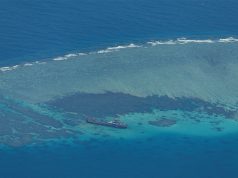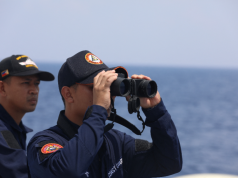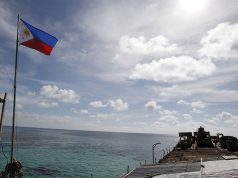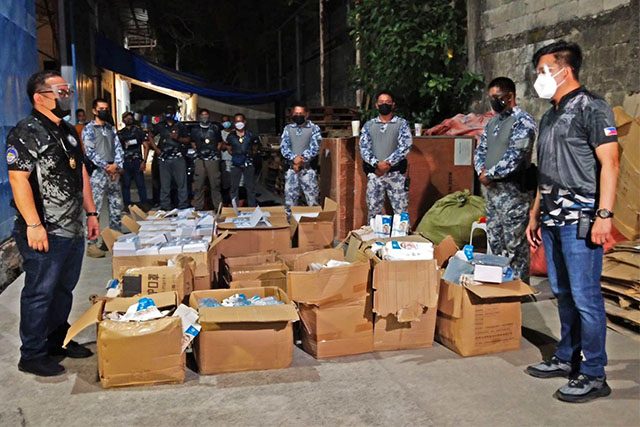
Questions about a face shield’s supposed authenticity surfaced after authorities seized items reported to be counterfeits of a known brand in a warehouse in Parañaque City last week.
The National Bureau of Investigation, Bureau of Customs and the Philippine Coast Guard discovered P70 million worth of “alleged fake and smuggled” versions of the Chinese-made Heng De face shield in BF Homes, Parañaque on May 20.
According to PCG, the face shields “did not pass appropriate inspection and may not be declared safe for use by the Food and Drugs Administration (FDA).”
Based on reports, the owners of the warehouse were not present when the authorities arrived.
The “fake” face shields will be destroyed after a proper investigation is conducted.
The supposed counterfeit version of the face shield prompted some members of the local online community to question what makes the personal protective equipment “fake.”
“Fake face shield—(when) can’t see through it? LOL,” COMELEC spokesperson James Jimenez commented on Twitter.
“How is a freaking face shield fake? Hahahaha!” journalist Barnaby Lo tweeted.
“That’s my initial reaction! May original na face shield ba???” Sen. Sherwin Gatchalian responded to him.
“Like, how?! Nalulusaw ‘yung plastic sa mukha mo ‘pag naarawan? Ganern?? Pangalawa…. MAS PEKE PO ‘YUNG PINIPILIT NA IPAGAMIT SA TAUMBAYAN ‘YAN KAHIT WALANG SIYENSYA NA SUMUSUPORTA,” former “Survivor Philippines” castaway Kiko Rustia exclaimed.
“What does fake fae shield even mean lol (laughing out loud) does it not block the virus out of your face?” another Twitter user commented.
A different Twitter user claimed that the “fake” label could also pertain to how it could supposedly be “in violation of the [intellectual property rights] for the brand Heng De.”
Last March, face shields were similarly seized in another warehouse in the same city.
Authorities reportedly filed charges of violation of the Republic Act 10863 or the Customs Modernization and Tariff Act and Intellectual Property Laws of the Philippines to the owners.
Alleged bogus transactions involving face shields also became rampant last year as the demand for it arose when the government started encouraging its use.
FDA Philippines on the same month that time released an advisory saying that it does not regulate face shields.
“Thus, no FDA authorization or certification is required for the importation and distribution of face shield,” it said on August 2020.
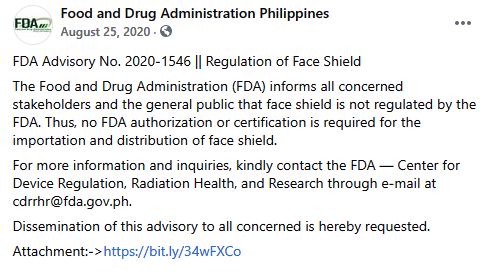
The regulatory agency, meanwhile, has been issuing public advisories about face masks, a necessary personal protective equipment in the COVID-19 pandemic.
Some notes on COVID-19 transmission
The use of face shields in public has been scrutinized after recent studies noted the airborne transmission of the virus.
Early in the pandemic, the droplets transmission of COVID-19 was emphasized by the World Health Organization which eventually prompted the government to make it mandatory in public places.
Droplets transmission focused on respiratory droplets emitted by a person when talking, coughing, sneezing or exhaling.
The WHO recently updated its COVID-19 Q&A page last April by saying that people “can be infected when aerosols or droplets containing the virus are inhaled or come directly into contact with the eyes, nose, or mouth.”
“The virus can also spread in poorly ventilated and/or crowded indoor settings, where people tend to spend longer periods of time. This is because aerosols remain suspended in the air or travel farther than 1 meter (long-range),” it added.
Last year, a Forbes article noted that face shields and Plexiglass barriers “are not a safe alternative to covering your nose and mouth.”
The article cited a document reportedly created by a group of scientists as organized by aerosol researcher Jose-Luis Jimenez of the University of Colorado, Boulder.
“Face shields do not offer much protection against aerosols (also see this video), while masks do,” part of its note said, linking a 2014 study.
Airborne transmission is when droplets less than or equal to five micrometers in diameter (referred to as droplet nuclei or aerosols) “remain infectious when suspended in air over long distances and time,” according to WHO.
Droplets that are greater than five to ten micrometers in diameter are classified as respiratory droplets.





